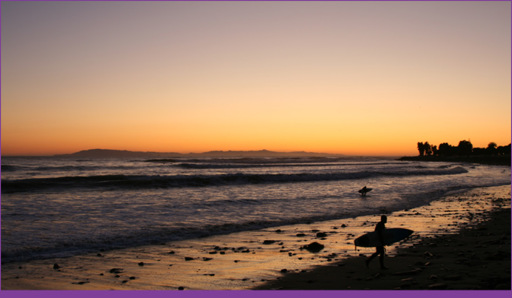Channel Islands - Introduction

Surfing at Ventura Beach with the Channel Islands in the distance
Off the coast of California, less than 100 miles away from 18 million people living in the Greater Los Angeles Area, is a group of eight islands. Compared to their surroundings, the Channel Islands have been left undeveloped even after continuous inhabitation for at least the last 8,000 years. Five of these islands—Santa Barbara, Anacapa, Santa Cruz, Santa Rosa, and San Miguel—comprise Channel Islands National Park. Rich history combined with incredibly diverse and often unique ecology make these volcanic islands stand alone in the National Park portfolio.
The park’s geology is constantly changing thanks to relentless pounding of water on rock. However, the most startling change to the islands wasn’t caused by water’s erosive powers, but by its absence. More than 13,000 years ago, a blink of an eye in geologic terms, the four northern islands were one super-island. North America was in the middle of the last great Ice Age and water level was much lower than it is today. Climatic changes caused the glaciers to recede. As water levels rose the lowest valleys flooded, ultimately disconnecting the islands from one another.
Geologic changes also drastically altered the islands’ ecology. Approximately 20,000 years ago, mammoths swam to the super-island, likely searching for vegetation whose scent was carried by the prevailing westward winds. As their population grew, resources became depleted. Natural selection favored smaller mammoths capable of surviving on less food. The woolly beasts lived on the islands for about 10,000 years before becoming extinct. Evidence of mammoths—once the most widely spread mammal—has been found on four continents. An engraving on a tusk found in a rock shelter in southwestern France. The carcass of a baby male preserved frozen in Siberia’s permafrost. More than 100 mammoth remains at the bottom of a sinkhole in Hot Springs, SD. And a pygmy mammoth here on Santa Rosa Island. When these miniature remains were discovered in 1873 scientists believed that elephants inhabited the islands. More than 100 years later, additional fossils helped conclude that they were in fact pygmy mammoths, about one-tenth the size of a typical Columbian mammoth. They measured between 4.5 and 7-feet tall, weighing about one ton. A Colombian mammoth measured up to 14-feet tall, and weighed as much as ten tons. Human fossils have also been found on the Channel Islands. At Arlington Springs, on Santa Rosa Island, scientists discovered human remains dating back more than 13,000 years. This find has become known as Arlington woman, and it is among the oldest remains found in North America.
Humans have had a considerable effect on the islands. Early Chumash people relied on the sea for food and tools, traveling between the islands and mainland in canoes, called tomols, hollowed out from redwood trees that drifted down the coast. The Chumash were present when Juan Rodriguez Cabrillo reached San Miguel Island in 1542. Cabrillo and his fellow explorers introduced disease and overhunted sea life; by the 1820s the entire surviving island Chumash population had moved to the mainland.
Over the course of the next century, the island was home to Mexican prisoners, ambitious ranchers, and hermit fishermen. In 1864, the Civil War increased demand for wool and more than 24,000 sheep grazed the hills of Santa Cruz. During prohibition, Raymond “Frenchy” LeDreau watched over caches of liquor stored in Anacapa’s caves. When Santa Cruz became part of the new National Monument, Frenchy was allowed to remain on the island as its caretaker. In 1956, at the age of 80, he was forced to leave after suffering severe injuries due to a fall. In 1969, more than 100,000 barrels of crude oil spilled into the Channel during the Santa Barbara oil spill, at the time the largest oil spill in United States waters. The National Park Service and Nature Conservancy have worked since to preserve this picturesque landscape and its unique ecosystem for the thousands of visitors that arrive each year.